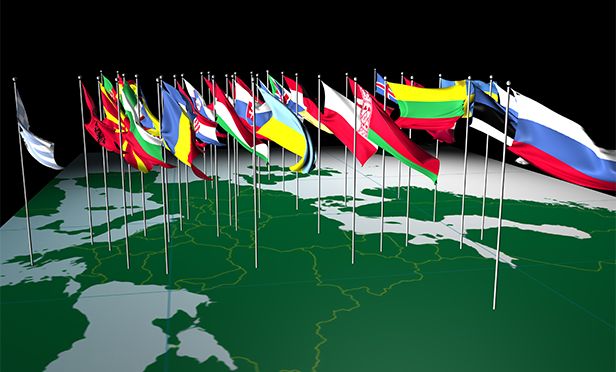
Russia is often painted as a villain in the news cycle thesedays, but the business environment there—and throughout Central and Eastern Europe—is more complex, andmore promising, than it may appear to casual outside observers.
|The region experienced strong growth in 2018, thanks to domesticdemand fueled by tightening labor markets, high wage growth, andlow borrowing costs, among other factors. As we head into 2019,conditions look favorable for that demand to remain high. Moreover,the business environment in Central and Eastern Europe is largelypositive—for now. Strong institutions and a proximity to WesternEuropean markets, which enables easy integration with the supplychains of major companies in the West, combine to support anoptimistic outlook.
|Still, clouds are gathering on the region's horizon as a resultof geopolitical uncertainty and the related issue of unorthodoxpolicymaking. Europe is already split in an east-west divide alongCold War lines. Some populist governments in the east have recentlydriven up political and social tensions by launching policies thatundermine democratic institutions and threaten to derail long-termgrowth. In Russia and Turkey, in particular, leaders who aredemonstrating authoritarian tendencies and stoking geopoliticaltensions are undermining the confidence of the business communityand increasing economic uncertainty.
||
A Primer on Russia
Since Russia is so much larger than the other countries inCentral and Eastern Europe, changes to its business environment arelikely to affect its neighbors. Atradius analysts predict thatRussia's gross domestic product (GDP) will grow modestly in 2019,as a result of increased oil prices, relatively low inflation, andbusiness and consumer confidence. However, the projected 1.5percent growth is slightly lower than last year's 1.8 percent. Thisdownshift reflects Russia's plan to increase its value-added tax(VAT) from 18 percent to 20 percent and a prediction that inflationwill continue to rise gradually.
|An ongoing escalation of tensions between Russia and the Westwould likely slow the economy further. If President Trump were towithdraw from the nuclear arms treaty—as he has threatened todo—security risks would rise. Actual military conflict is notlikely, but any loss of confidence in the Russian economy orincrease in organizations' perception of the risk of doing businessin the country could have long-term negative effects.
|For most American businesses trading with Russian firms, thebiggest cause of worry at the moment is the threat of furthersanctions, which could destabilize the Russian economy and exertdownward pressure on the ruble. The United States first imposedsanctions when Russia annexed Crimea in 2014. They were ratchetedup after Russia's alleged meddling in the 2016 presidentialelection, followed by additional sanctions after Russia's allegedattack on former intelligence officer Sergei Skripal and hisdaughter. Analysts expect to see new sanctions again in 2019.
|This is bad news for the Russian currency. Sanctions arecontributing to a weakening of the ruble, which has fallen about 5percent against the U.S. dollar over just the past six months.Fixed investment has also taken a hit: Russia saw only 1.2 percentgrowth in foreign investment in 2018, a sharp decline from the 4.3percent growth of 2017.
||
Turkey: Trouble Ahead
Turkey may be the least stable country in the region. This fall,the Turkish economy finally boiled over as a result of a slowresponse to surging inflation and recent policy mistakes, includingthe removal of former constitutional checks and balances, theincrease of government leverage on formally independentinstitutions such as the Central Bank, and the detention ofjournalists and human rights activists with EU citizenship.
|The Turkish government has taken some steps to correct itsmistakes, but the damage is done, at least for the short term. RealGDP growth slowed from 7.4 percent in 2017 to around 3.9 percent in2018. The initial forecast for 2019 predicts a recession, with adecline in GDP of 1.7 percent. This comes on top of a majorcurrency crisis—year to date, the Turkish lira is down nearly 30percent. Inflation is extremely high, and interest rates aresoaring at around 24 percent. Together, all these factors arehaving a devastating effect on productivity and consumerconfidence. Turkey is currently experiencing a high level ofcorporate insolvencies, which are expected to increase another 15percent in 2019, to the highest level in five years.
|What's more, some of Turkey's attempts to turn these trendsaround by micromanaging the economy could backfire and spookforeign investors again. The Turkish government has recentlyinstituted a requirement for exporters to convert a large share oftheir foreign currency back to lira and has tightened restrictionson the use of foreign currency in domestic transactions. Suchquestionable market interventions are likely to make foreigncompanies think twice before investing in Turkey, which wouldundermine hopes of an economic recovery.
||
Times Are Uncertain, but Opportunities Remain
Other Central and Eastern European countries are facing similarchallenges as a result of political decisions or social turmoil. InHungary, economic uncertainty is on the rise, as the European Union(EU) recently imposed Article 7, opening the door for potentialsanctions designed to deter antidemocratic policies. The EU actionwas a response to the Hungarian government's efforts to silence thecountry's media, target nongovernmental organizations (NGOs), andremove independent judges from the bench. Poland was hit with thesame ruling earlier in 2018 for undermining the independence of itsjudiciary.
|Atradius expects these types of tensions to arise in othercountries in the region throughout 2019. If this assessment iscorrect, the trend might further dampen investor interest in theregion, despite the relative attractiveness of Central and EasternEurope due to low labor costs, geographical proximity to WesternEuropean markets, and flexible exchange rates.
|If governments in Central and Eastern Europe take blatantlyantidemocratic actions in the next year, those policy mistakescould have medium- to long-term consequences for the economies ofthe region. Continued convergence with the rest of the EU is goingto require ongoing investment in public infrastructure andorganizational productivity. EU resources are vital for this, butthe EU is considering reducing the structural funding available inits 2021–2027 budgets for countries with unacceptable policiesaffecting the stability of democratic institutions, the rule oflaw, and immigration.
|Nevertheless, Central and Eastern European economies are stillstrongly pro-business, for the most part, and will likely continueto be for some time to come. The Czech Republic stands out asparticularly stable. Although the Czech government has adoptedpopulist rhetoric recently, particularly surrounding immigration,the same leaders' policies remain business-friendly and pro-EU.They continue to encourage foreign capital inflows and havedeveloped a financial buffer against the predicted global downturn.This buffer comes from a strong track record of fiscal prudence anddebt servicing, contributing to the country's low public debtlevels, which will help protect the Czech Republic from slowerregional or global growth.
|As always, leaders of companies with interests in foreignjurisdictions need to stay abreast of global geopolitical risks, aswell as the economic and political developments within individualcountries. Working with a trade credit insurer is one way to keepinformed of the economic health of individual countries andsectors.
|
 Dana Bodnar is aneconomist at Atradius, responsible for macroeconomic and countryrisk analysis specializing in Central and Eastern Europe. Shejoined Atradius in 2014 after completing her master's degree ininternational economics at Utrecht University in theNetherlands.
Dana Bodnar is aneconomist at Atradius, responsible for macroeconomic and countryrisk analysis specializing in Central and Eastern Europe. Shejoined Atradius in 2014 after completing her master's degree ininternational economics at Utrecht University in theNetherlands.
|
|
 Arkadiusz Taraszkiewiczis a senior manager of Central and Eastern European riskservices at Atradius Credit Insurance. He earned his executive MBAfrom the European University in Montreux, Switzerland. He has beenworking in financial institutions for more than two decades and hasbeen with Atradius since 2001.
Arkadiusz Taraszkiewiczis a senior manager of Central and Eastern European riskservices at Atradius Credit Insurance. He earned his executive MBAfrom the European University in Montreux, Switzerland. He has beenworking in financial institutions for more than two decades and hasbeen with Atradius since 2001.
Complete your profile to continue reading and get FREE access to Treasury & Risk, part of your ALM digital membership.
Your access to unlimited Treasury & Risk content isn’t changing.
Once you are an ALM digital member, you’ll receive:
- Critical Treasury & Risk information including in-depth analysis of treasury and finance best practices, case studies with corporate innovators, informative newsletters, educational webcasts and videos, and resources from industry leaders.
- Exclusive discounts on ALM and Treasury & Risk events.
- Access to other award-winning ALM websites including PropertyCasualty360.com and Law.com.
*May exclude premium content
Already have an account? Sign In
© 2024 ALM Global, LLC, All Rights Reserved. Request academic re-use from www.copyright.com. All other uses, submit a request to [email protected]. For more information visit Asset & Logo Licensing.







